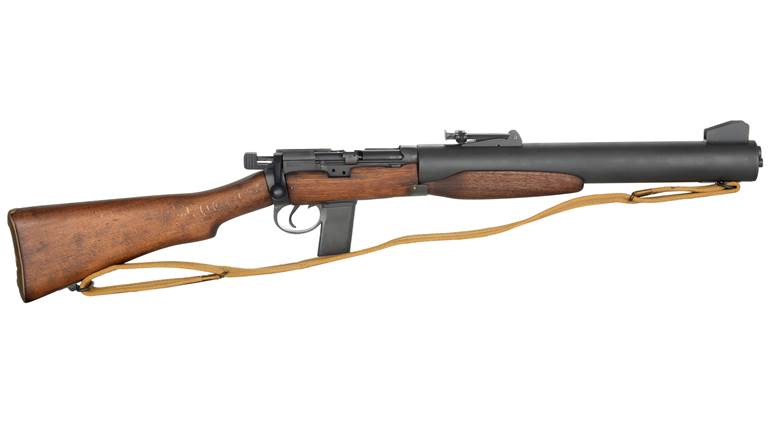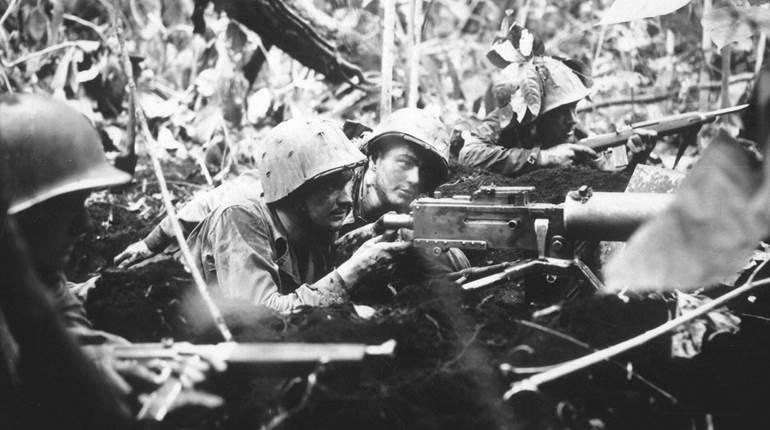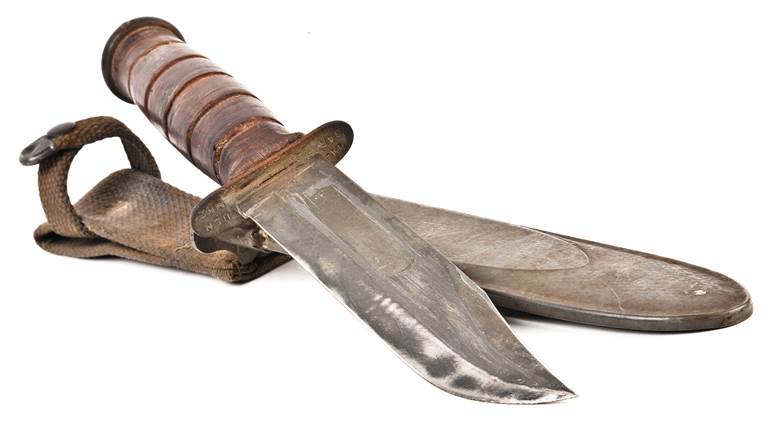
When we think of the firearms used by U.S. forces during World War II, the AN/M2 .50-caliber machine gun doesn’t exactly jump to the front of the line. Nevertheless, it was in action from Sunday, Dec. 7, 1941, through Aug. 18, 1945, when the gunners on two B-32 Dominators used it to fire America’s final shots of the conflict. During the 1,350 days in between, the .50-cal. AN/M2 served in the air, on land and at sea, and it was a part of every major battle in every theater of operations around the world. That is something that cannot be said about any other U.S. military firearm that was in service at the time.

August 18, 1945
At 05:43 hours, a pair of B-32s took off from Yontan Airfield, Okinawa, to photograph various locations around Tokyo Bay. Technically the war had ended three days earlier, so the mission was supposed to be routine—until the Japanese attacked. At first, the B-32s drew “heavy and inaccurate” anti-aircraft fire as they passed over the airfield at Miyakawa, but, shortly thereafter, they were intercepted by 17 Japanese fighters. During the two-hour-long aerial engagement, gunners aboard both American bombers fought off their antagonists with heavy volumes of effective machine gun fire; the B-32 was a particularly well-armed aircraft. It mounted Sperry A-17 turrets in the nose and tail, a pair of Martin A-3F-A dorsal turrets aft of the cockpit and a single Sperry A-13-A ball turret in the ventral position. Each one was armed with a pair of AN/M2 .50-cal. machine guns. Through 10 separate firing passes, the Japanese fighters strafed the big American bombers, which fought back with their AN/M2s, firing more than 4,000 rounds of .50-cal. ammunition. One B-32 suffered multiple hits that damaged the aircraft and fatally wounded 20-year-old Sgt. Anthony J. Marchiano. He was the last American to be killed as a result of enemy action during World War II.

The Origin Story
The AN/M2 .50-cal. machine gun had its origins in John M. Browning’s Model of 1917 .30-cal. machine gun. Its short-recoil-operated, belt-fed design was a success on the battlefield, albeit only during the closing weeks of World War I. General John J. Pershing requested the development of a larger-caliber gun, and Frankford Arsenal quickly scaled-up the .30-cal. cartridge to produce the 12.7x99 mm—known today as .50 Browning Machine Gun or BMG. Browning scaled-up the M1917’s design to chamber the new cartridge. He completed the design in 1918, and it entered service in 1921 as the water-cooled Model 1921 WC. In May 1923, an air-cooled version was standardized, but it could only feed from the left side. Since that was not entirely ideal for mounting multiple guns in the cramped confines of an aircraft, Browning modified the design so it could feed from either the left or the right. The Model 1923 was standardized for “Army/Navy” use as the AN/M2 aircraft machine gun on Oct. 5, 1933. Because of a lighter bolt and a substantially lighter 36" barrel, it produced a higher cyclic rate than its ground combat counterpart, the M2HB. Whereas the M2HB had fired 450 to 575 rounds per minute, the AN/M2 approached 850. Even though its lightweight barrel did not possess the same heat-dissipating characteristics as the M2HB, the AN/M2 .50-cal. was intended to operate in flight at high altitudes where cooler temperatures and fast-moving airflow would prevent overheating. It was also lighter than the 84-lb. M2HB, 23 lbs. lighter to be precise. A distinctive ventilated barrel jacket and muzzle booster even made it look quite a bit different than the M2HB. The AN/M2 could be used on either a rigid mount for offensive purposes or a hand-operated mount for defensive purposes, and it could be fired mechanically using a trigger or electrically using a solenoid.
When the U.S. Congress dramatically increased funding for the rapidly expanding U.S. Army Air Corps in 1939, it was necessary to increase production of aircraft machine guns. Toward that end, the Ordnance Dept. awarded a $20 million educational contract to General Motors to modify and equip some of its manufacturing plants for the purpose. Then, in September 1940, GM was awarded a $61.4 million contract to produce 71,225 machine guns of four types, one of which was the AN/M2. The GM plants that soon thereafter began producing that gun were Frigidaire in Dayton, Ohio, and A.C. Spark Plug in Flint, Mich. General Motor’s Brown-Lipe-Chapin Division in Syracuse, N.Y., would also produce the AN/M2 .50-cal. alongside High Standard, Savage Arms, Buffalo Arms, Kelsey-Hayes and Colt. Production of the AN/M2 surged just as the war clouds over Europe and Asia began to look more menacing.

December 7, 1941
When the Japanese navy carried out their attack on all of the military installations on the island of Oahu, including the U.S. Navy base at Pearl Harbor, Americans did not cower in fear—they fought back, and they did so using every arm available to them. While the M1903 rifle and even the M1911A1 pistol were used against attacking Japanese aircraft, the big hero of U.S. small arms that day was the AN/M2. At several locations across the island, the machine guns were swiftly put into action in improvised positions, and it did not take long for them to show their worth. At Hickam Army Airfield, AN/M2s that were supposed to be used as defensive armaments on B-17s were instead placed within a bomb crater and aimed at the sky. On Ford Island, sailors and Marines retrieved both .30-cal. and .50-cal. AN/M2s from ordnance storage lockers for the three patrol squadrons stationed there and mounted the guns in expedient positions made of sandbags, wood and sometimes even tent canvas. A position on Ford Island had AN/M2 .50-cals. mounted using an adaptor system equipped with a rubberized buttpad fixed to the back end of the cradle assembly, a pistol grip/trigger mechanism on the side of the cradle and a tower for mounting a telescopic sight.

Fourteen miles to the northeast, at Naval Air Station Kaneohe Bay, sailors also set up temporary fighting positions for AN/M2s. In a ditch for a sewage line, five sailors set up a pair of AN/M2s—a .30-cal. and a .50-cal. They used some of the framing structures in the ditch as field-expedient platforms, and tied sections of rope to secure the guns. Nearby, on the parking ramp for Patrol Squadron (VP) 11, CPO John William Finn directed his sailors in setting up several AN/M2s and their instructional/training tripods. As the squadron’s highest-ranking aviation ordnanceman, he was not just familiar with the operation of these guns, he also had full access to them and the ammunition they needed. Over the course of the next two hours, Finn personally operated an AN/M2 .50-cal., directing effective machine gun fire against attacking Japanese aircraft. Because he was firing from an exposed position, the 32-year-old drew return fire and suffered painful wounds, but he kept on fighting. After the raid was over and he had received cursory medical attention, he supervised the re-arming of returning aircraft. Nine months later, Finn was awarded the Medal of Honor for his actions on Dec. 7, 1941.
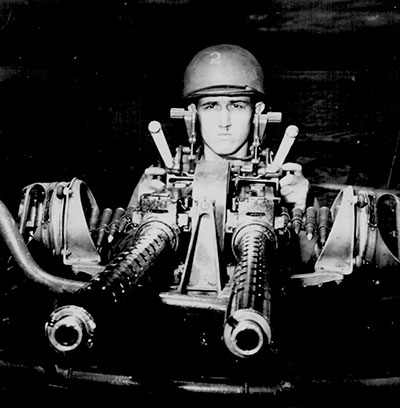
U.S. Army Air Corps aviators also put the AN/M2 .50-cal. to good use that day. When the attack began, aircraft of the 47th Pursuit Squadron were temporarily based on the north shore of Oahu at the auxiliary airfield near Haleiwa to conduct remote field gunnery training. As bombs began to fall on Wheeler Army Airfield, a group of pilots from the squadron rushed the 10 miles to Haleiwa and took to the air to oppose the enemy, but only .30-cal. ammunition was available there. Second Lt. George S. Welch and 2nd Lt. Kenneth M. Taylor both took off in B model P-40 Warhawk fighters, which were each armed with two .30-cal. AN/M2s in the wings and two AN/M2 .50s in the cowling. When they first joined the unfolding air battle above Oahu that morning, only their wing guns were loaded. Once in the air, Taylor and Welch climbed to 8,000 feet and flew south to Barber’s Point. There, they observed a formation of 12 “Val” dive-bombers and, despite six-to-one odds, both attacked. Although each man shot down one enemy dive-bomber, they quickly ran out of ammunition. Both pilots then flew 13 miles to the north, landed at Wheeler Army Airfield and taxied to an ammunition replenishing point. There, ground crewmen reloaded their wing-mounted AN/M2 .30s, and gave both P-40s a full load of .50 BMG as well. They did not take on fuel—just the ammunition that let them get back into the fight. The two pilots then roared into the air again and began dogfighting over Wahiawa. By the end of the air battle, Welch had shot down four enemy aircraft and Taylor had scored two confirmed kills with two probables. In recognition for their extraordinary heroism in action, both received the Distinguished Service Cross.
The day after the attack on Pearl Harbor, the United States declared war on the Empire of Japan, and the AN/M2 .50-cal. that had performed so well on December 7 was back at work in the skies over the Pacific. In February 1942, the U.S. Navy launched a series of “hit-and-run” aircraft carrier raids against remote island outposts of Japan’s oceanic empire starting with the Marshall and Gilbert islands.

February 20, 1942
On February 20th, U.S.S. Lexington was moving into position to launch a surprise air raid on the Japanese fleet anchorage at Rabaul, New Britain, when it was spotted by a Japanese flying boat. The ship was still 450 miles northeast of Rabaul when this happened, so the element of surprise was suddenly lost and the Japanese responded by launching 17 “Betty” bombers in two groups to sink the American carrier. Shortly after 4:30 p.m., the first group of Bettys closed in on Lexington only to be met by fighters from the ship’s combat air patrol. Although all nine bombers from the first group were brought down in minutes, when the second group approached from another direction shortly before 5 p.m. only two fighters were in a position to intercept them. They were both Grumman F4F-3 Wildcats armed with four AN/M2 .50-cals. each, but one of the aircraft could not fire a shot because its guns were jammed. That meant the other fighter, piloted by Lt. Edward “Butch” O’Hare, would have to protect Lexington alone. Without hesitating, O’Hare dove in on the formation and began firing. He had to make his bursts count because the F4F-3 carried only 450 rounds per gun. In three separate passes, he sent one bomber after the other tumbling toward the sea, but all the while the running air battle was creeping closer and closer to Lexington—so close that the remaining Bettys were nearing their bomb-release point. When O’Hare began his fourth pass, the four AN/M2 in his wings began chattering away, but then abruptly fell silent when the ammunition ran out. He pulled away and let Lexington’s anti-aircraft guns open fire on the four remaining Japanese aircraft. All their bombs missed, and the ship sustained no damage. Had the fearless naval aviator not been there to interfere with the Japanese bombing run, the ship would have probably been damaged or maybe even sunk. Instead, Butch O’Hare boldly threw his Wildcat at the bomber formation over and over again until he could do nothing more to stop them. He was the right man at the right place at the right time, he had an excellent aircraft and he had four heavy-hitting AN/M2 .50s to get the job done. Because of his conspicuous bravery, Butch O’Hare was subsequently recommended for the Medal of Honor. President Franklin D. Roosevelt presented that award to the young lieutenant at the White House on April 21, 1942, with a citation that concludes with these words: “As a result of his gallant action—one of the most daring, if not THE most daring single action in the history of combat aviation—he undoubtedly saved his carrier from serious damage.”
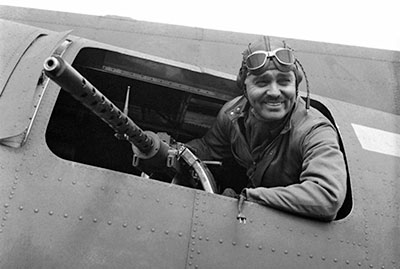
On April 18, 1942, 16 B-25B Mitchell medium bombers flew from U.S.S. Hornet in the now-famous Doolittle Raid. Each was equipped with a dorsal turret armed with a pair of .50-cal. AN/M2s. But that was really only the beginning of the B-25’s special relationship with the AN/M2. The B-25 went through field modifications that upgunned it with AN/M2 .50s in external blisters on both sides of the fuselage, as well as in the aircraft’s nose. This paved the way for factory-built B-25 gunships mounting as many as—in the example of the B-25J gunship—14 forward-firing AN/M2 .50-cal. machine guns.

The AN/M2 .50 played a critical role in all of the pivotal engagements of the Pacific. From the Battles of the Coral Sea and Midway, to the decisive six-month-long air, sea and land campaign on Guadalcanal in the Solomon Islands. It made a significant contribution to the struggles for New Guinea and the Philippines, and it is the weapon that brought down Admiral Isoroku Yamamoto on April 18, 1943. The AN/M2 .50 also brought down hundreds of Japanese aircraft during the Great Marianas Turkey Shoot in June 1944, and it participated in the destruction of the super battleships Musashi and Yamato. It armed submarines, PT boats and the B-29s that brought strategic bombing to the Japanese home islands. It was literally everywhere. But for all of the critical contributions it made in the Pacific, we have to remember that it made equal contributions to the war in the China-Burma-India theater as well. In fact, a former U.S. Navy fighter pilot named James H. Howard used AN/M2 .50-cals. mounted in a P-40 Warhawk to shoot down six Japanese aircraft while he was a member of the American Volunteer Group, better known as the Flying Tigers. Fast-forward a year and a half, and Howard had by then become a U.S. Army major in the European Theater of Operations (ETO). As commanding officer of the 356th Fighter Squadron based in England, he was regularly flying combat missions in the skies above the Third Reich.
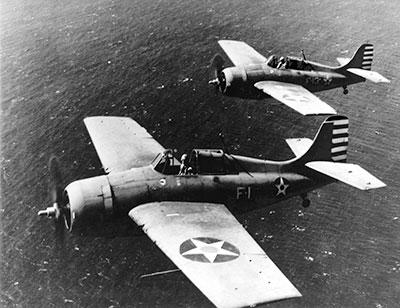
January 11, 1944
During a bomber escort mission to the town of Oschersleben on Jan. 11, 1944, Howard single-handedly attacked a formation of 30 German fighters with his P-51B Mustang and the six .50-cal. AN/M2s in its wings. Without the tactical advantages of either altitude or surprise, he engaged in a 30-minute running dogfight against the Luftwaffe fighters that opposed and outnumbered him, destroying at least three. It was an exceptional act of both bravery and skill that a Stars and Stripes correspondent named Andy Rooney later described as being “the greatest fighter pilot story of World War II.” Howard would ultimately be awarded the Medal of Honor for what he did that day in the skies above Oschersleben with six AN/M2 .50s. But while he was dogfighting and trying to hold off the Luftwaffe, gunners on the 401st Bombardment Group B-17s above him were fighting for their lives using the same gun.
As the primary defensive arm of USAAF bombers, the AN/M2 .50-cal. was a part of each and every raid flown against targets in Europe during the war, and it provided thousands of gunners the firepower that would give them a fighting chance to survive modern air combat. The gun’s role in the ETO began with the Eighth Air Force raids against targets in occupied France in August 1942. It was there defending the bombers during the Operation Gomorrah raids that created firestorms in Hamburg in July 1943. It was there the following month during the infamous Schweinfurt–Regensburg shuttle mission and it was there for the “Big Week” assault against the German aircraft industry in early 1944. The bombers and fighters that supported D-Day and the Battle of the Bulge were armed with it, and it destroyed its fair share of railroad rolling stock in spectacular strafing missions that unfolded as the end of the war in Europe began to draw near, which it did on April 9, 1945.

April 25, 1945
Never before had Allied aircraft attacked the settlement known as Obersalzberg near Berchtesgaden in southern Bavaria, which was the location of Adolf Hitler’s private residence, the Berghof - but the time had finally come. Although the Führer was not there at the time, over 350 RAF bombers would carry out a large-scale raid against the target with the support of 98 P-51s from the U.S. Army’s Eighth Air Force. One of the Mustangs flying the mission that day was piloted by 1st Lieutenant Hilton O. Thompson of the 434th Fighter Squadron, 479th Fighter Group. His infiltration to the target had been long and routine, but then shortly before noon something out of the ordinary happened as the flight approached the Obersalzberg area. While scanning the sky, 1st Lieutenant Thompson spotted an aircraft flying in an easterly direction 2,000 feet directly above him. Without hesitating, he signaled his wingman to follow and began climbing toward the enemy aircraft which turned out to be an Arado Ar 234.
When he was 800 yards from the twin-engine bomber, Thompson fired two short bursts from his six AN/M2 .50-caliber machine guns, and those bursts struck the German jet’s left engine. He then closed-in rapidly from seven o'clock astern, fired several more bursts from between 600 and 300 yards, and those bursts inflicted fatal damage to the left side of the Arado’s fuselage. When the Mustang was just 200 yards away, Lt. Thompson stopped firing, pulled to the right and watched the stricken jet spiral down from 24,000 feet and crash near Berchtesgaden. He had fired a total of 1,571 rounds of .50-caliber ammunition to bring-down the jet, which was his second aerial victory. When the war in Europe ended just two weeks later, it was recognized that there was an historical value associated with the six AN/M2 .50s in Thompson’s Mustang because they had been used to bring down a German jet bomber during the raid that destroyed Adolf Hitler’s home.
In recognition of that, the Headquarters of the Eighth Air Force had all six guns sent to the Headquarters of the U.S. Army Air Forces in Washington, D.C. and, decades later, they found their way to the Springfield Armory National Historic Site in Massachusetts. They are still there today but they are not displayed in the museum’s exhibit. That’s where you find examples of the firearms that have traditionally been more closely identified with the American experience in World War II. The six AN/M2 .50s from Hilton Thompson’s P-51 are in artifact storage where they are preserved and protected, just not on public display. In a way, it is fitting of the gun’s somewhat less than prominent role. When we think of the firearms used by U.S. forces during World War II, the AN/M2 .50-caliber machine gun doesn't exactly jump to the front of the line.
Nevertheless, it was in action from day one – Sunday, December 7, 1941 – through to August 18, 1945 when the gunners on two B-32 Dominators used it to fire the USA’s final shots of the conflict. During the 1,350 days in between, the AN/M2 .50 served in the air, on land and at sea, and it was a part of every major battle in every theater of operations around the world. That is something that cannot be said about any other U.S. military firearm that was in service at the time. It was the principal tool used in thousands of combat actions that resulted in the awarding of decorations like the Navy Cross, the Distinguished Service Cross, and the Medal of Honor. Considering the significant contribution to the war effort that it made and its relative obscurity in the history of U.S. small arms, the AN/M2 .50-caliber machine gun is truly the unsung hero of U.S. firepower during World War II.













